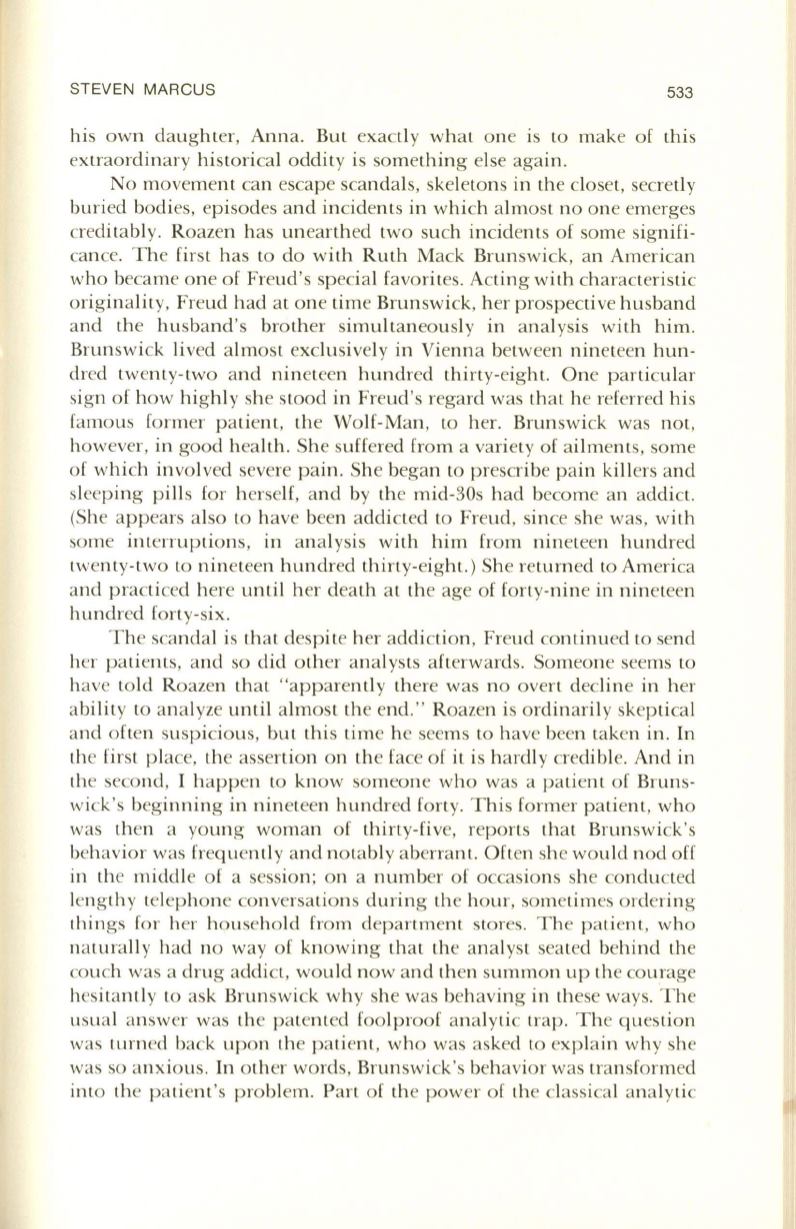
STEVEN MARCUS
533
hi s own daughter, Anna. But exactl y wha t one is to make of this
extraordina ry historical oddity is something else aga in.
No movement can escape scandals, skeletons in the closet, secretly
buried bodies, episodes and incidents in whi ch almos t no one emerges
creditabl y. Roazen has un earthed two such incidents of some signifi–
cance. The first has
to
do with Ruth Mack Brunswick, an American
who became o ne o f Freud 's special favorites. Acting with cha racteristic
originality, Freud had at on e time Brunswick, her prospective husband
and the husband 's brother simultaneou sly in analysis with him.
Brunswick lived almos t exclusive ly in Vienna between nineteen hun–
dred twenty-two and nineteen hundred thirty-eight. One pa rticular
sign o f how highl y she stood in Freud' s regard was tha t he referred his
famo us fonner pa tient, the Wolf-Man ,
to
her. Brunswick was not,
however, in good hea lth . She suffered from a vari ety of ailments, some
of whi ch invo lved severe pain . She began
to
prescribe pain kill ers and
sleeping pill s for herself, and by the mid- 30s h ad become an addi ct.
(She ap pears also
to
have been addi cted to Freud, since she was, with
some interrupti ons, in ana lys is with him from nineteen hundred
twenty-two to nineteen hundred thirty-eight. ) She returned
to
America
and practi ced here until h er dea th a t the age of forty-nine in nineteen
hundred forty-six.
T he scandal is tha t des pite her addi ction , Freud continued to send
her patients, and so did other analysts afterwards. Someone seems to
have told Roazen tha t "apparentl y there was no overt decline in her
ability to analyze until almos t the end. " Roazen is ordinaril y skeptical
and o ften suspicious, but thi s time he seems to have been taken in. In
the first place, the assertion on the face of it is ha rdl y credibl e. And in
the second , I happen
to
know someone who was a pa tient of Bruns–
wick's beginning in nineteen hundred forty. This fo rmer pa ti ent, who
was then a young woman o f thirty-fi ve, reports that Brunswi ck' s
behavior was frequentl y and notabl y aberrant. Often she would nod o ff
in the middl e o f a session ; on a number o f occas ions she conducted
leng th y telephone con versations during th e hour, sometimes o rdering
things fo r her ho usehold from department stores. T he pa tient, who
na turall y had no way of knowin g tha t the analys t sea ted behind the
couch was a drug addict, would now and then summon up the courage
hes itantl y to as k Brunswick wh y she was behaving in these ways. The
usual an swer was the pa tented foolproo f analytic trap. The question
was turned back upon the pa tient, who was asked to expl ain why she
was so anx io us. In o ther words, Brunsw ick's behavio r was transformed
into the pa tient 's p robl em. Part of the power of the cl assical analytic


